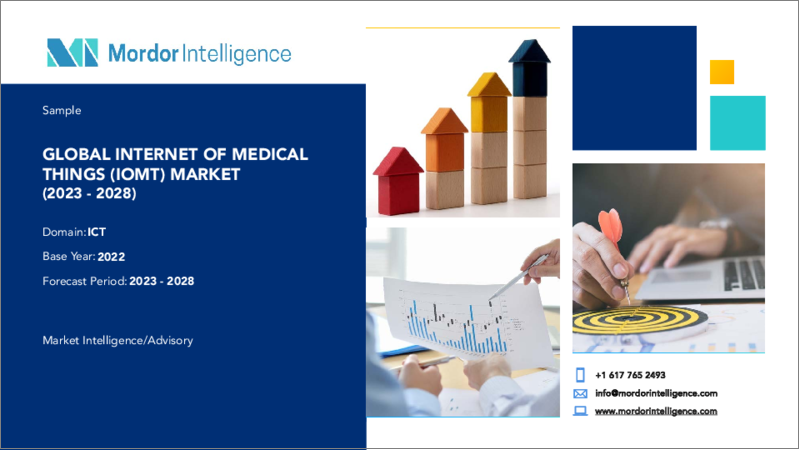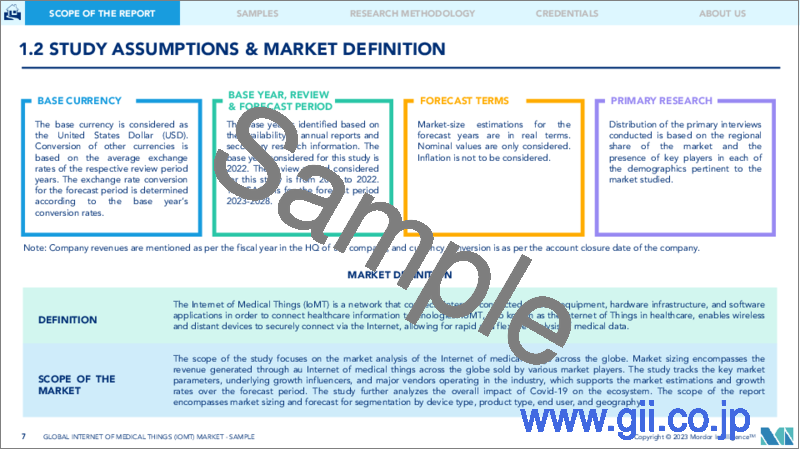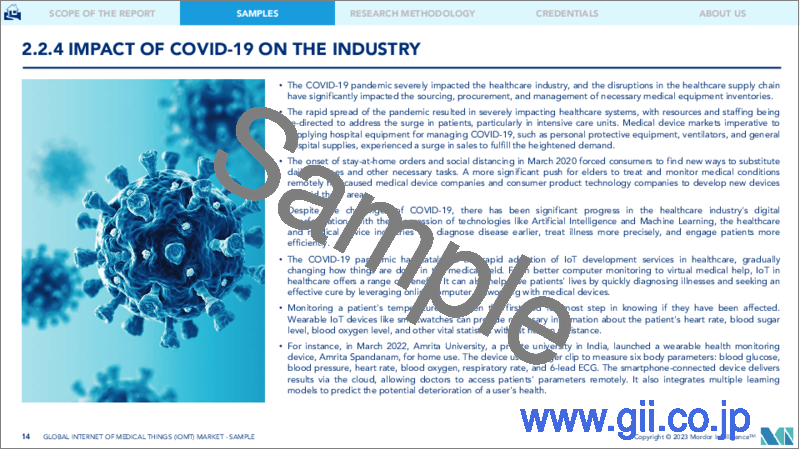|
|
市場調査レポート
商品コード
1137983
医療IoT(IoMT)市場- 成長、動向、予測(2022年~2027年)Internet of Medical Things (IoMT) Market - Growth, Trends, and Forecasts (2022 - 2027) |
||||||
|
● お客様のご希望に応じて、既存データの加工や未掲載情報(例:国別セグメント)の追加などの対応が可能です。 詳細はお問い合わせください。 |
|||||||
| 医療IoT(IoMT)市場- 成長、動向、予測(2022年~2027年) |
|
出版日: 2022年10月13日
発行: Mordor Intelligence
ページ情報: 英文 100 Pages
納期: 2~3営業日
|
- 全表示
- 概要
- 目次
医療IoT(IoMT)市場は、予測期間2022年~2027年にかけて23.4%のCAGRで推移すると予測されています。
薬物送達におけるコスト削減ニーズの高まりや、コネクテッドデバイスの浸透が、IoMT市場の成長に影響を与える重要な要因の一つとなっています。特に、ヘルスケアの成果を向上させるニーズや高速ネットワーク技術の進化は、IoMTデバイスの市場発展が期待される分野でもあります。しかし、ヘルスケア組織全体における適切なIoT技術スキルの欠如は、IoMT市場の成長を阻害すると予想されます。
主なハイライト
- 患者の安全性向上、医療過誤の減少、電子健康記録(EHR)のシームレスな転送、より良い疾病管理、慢性疾患の遠隔モニタリング、薬剤管理の改善など、いくつかの利点を持つIoT医療機器は、医療を変革し患者の転帰を改善すると同時に、コスト削減やより良い情報に基づくケアの決定をより信じられないほどの速さと容易さで行うのに役立つ可能性を秘めています。
- コネクテッドデバイスの普及拡大が市場を牽引する要因です。コネクテッドメディカルデバイスとは、WiFi、Bluetooth、無線通信によってインターネットに接続できる医療機器のことです。これらの医療機器は、病気の診断、治療、治癒、予防といった本質的な機能を超えたデジタル機能を持ち、他のネットワークやシステムとの統合や接続を可能にしています。IoMTは、コネクテッドメディカルデバイスとモバイルメディカルアプリケーションの力を借りて、データ(患者情報やパフォーマンスデータ)、人(患者、臨床医、介護者)、プロセス(医療提供や患者サポート)を結合させるものです。
- IoMTのメリットは、ミスの少ない正確な診断を低コストで実現し、それによって市場を牽引するヘルスケアの成果を向上させることです。モバイルアプリケーションによるIoTは、患者がヘルスケアデータを医師に転送することを可能にし、慢性疾患のモニタリングに役立ちます。
- 異なる医療機器の相互運用性と接続性のソリューションにかかる費用はかなり高額です。さらに、ITサポートと保守サービスには、変化するユーザー要件に応じたソフトウェアの修正とアップグレード、効率的なITインフラの維持が含まれ、定期的な支出を意味します。これは総所有コストに占める割合が大きいです。また、機器統合のための販売後のカスタムインターフェース開発には、ソリューションの正確性と完全性を確保するための追加的な検証と妥当性確認が必要です。これは、ヘルスケアプロバイダーの総所有コストをさらに増加させます。高いコストがかかるため、特に新興国の小規模なヘルスケア施設は、レガシーシステムを先進のIoT対応デバイスに置き換えることに消極的です。
- COVID-19のパンデミック時には、感染前と感染後の両段階で、予想外に膨大な数の患者の健康状態を継続的にモニタリングすることが不可欠とされています。医療IoT(IoMT)が可能にする遠隔医療による患者のモニタリング、スクリーニング、治療は、介護者、医療提供者、および患者によってうまく適応されています。IoMTベースのスマートデバイスは、特に世界のパンデミック状態において、急成長している影響を及ぼしています。しかし、膨大なニーズを考慮すると、ヘルスケアはIoMTにとって最も困難な分野であると言えます。
主な市場動向
コネクテッドデバイスの普及拡大
- ヘルスケア情報技術の技術的進歩により、ヘルスケア分野は大きく変貌を遂げています。IoMTは、複数の医療機器がネットワークに接続され、人間と機械の相互作用を必要とせずに健康データを交換するシステムです。これらのシステムや機器はインターネットに接続されており、遠隔地からの患者のモニタリングや診断が可能です。さらに、IoMTの利点は、患者の健康を鋭く理解するのに役立ち、患者に価値に基づいたケアを提供することは、患者、支払者、医療機関にとって有益であることです。
- IoT医療機関で使用される医療ツールやデバイスは、医療を独自に革新しています。グルコースモニター、ECGモニター、パルスオキシメーター、血圧計などの接続されたデバイスは、患者の体の近くに配置され、24時間体制の医療支援やサービスを提供することで顧客満足度の向上を保証しています。
- シスコは、あと5~6年で、世界中で500億台以上の機器がインターネットに接続されると予測しています。これらの接続機器のうち、約30%が医療分野に導入されると推定されています。導入プロセスにおけるメーカーの唯一の課題は、接続された医療機器が価値ベースのケアにどのように貢献できるかを示すことです。
- 医療モノのインターネット市場は、いくつかの市場変数と動向により、大きな成長を遂げています。成長は、主要なプレーヤーとエンドユーザーとの関係の拡大や、新しい商品の導入によって刺激されます。例えば、2021年6月、LifeQとCONNEQT Incは、ウェアラブルデバイスユーザーに健康インサイトを提供するためのパートナーシップ契約を発表しました。このバンドは、指先のセンサーを追加し、心臓の健康に特化した商品を補完するものです。
IoMTデバイスは北米が主要市場
- 北米は、患者の自己健康管理への関心の高まりと慢性疾患の増加により、予測期間中にIoT医療機器市場で最大のシェアを占めると予想されます。スマートフォンユーザーの増加、4G技術の浸透、ヘルスケアコストの上昇に対処する必要性などが、今後数年間の市場成長を促進すると予想されます。また、ヘルスケアITソリューションの採用が進んでいること、主要プレイヤーの存在、洗練されたインフラの利用可能性といったその他の要因も、この地域の大きなシェアに重要な役割を果たしています。
- 北米の医療IoT(IoMT)市場は、技術の進歩とパーソナルヘルスケアへのアクセス性の向上により発展してきました。一方で、病院や医療部門にインフラ設備や訓練を受けた専門家がいないことが、市場の拡大を妨げています。ヘルスケア分野におけるコネクテッドデバイスの需要は、北米の医療IoT(IoMT)市場に様々な機会を生み出すと予想されます。これにより、市場の将来は強固で先進的なものになる傾向があると思われます。
- いくつかの生活習慣病の有病率の増加による医療機器に対する需要の増加は、医療用ウェルネス機器のメーカーに巨大な機会を創出します。主要な市場参加者は、さまざまな市場を通じて製品を流通させ、製造するために協力的なアプローチをとっています。若年層やアスリートからの需要が大幅に増加しています。負傷したスポーツ選手は、主にカスタマイズされたモビリティケア、装具、ブレース、サポート製品を必要とし、この地域のIoMTをリードしています。
- そのため、技術の進歩は、新しい高度な機器の開発につながり、体温計、パルスオキシメーター、糖尿病モニターなどの製品の売上を押し上げることになります。このような多様なカスタマイズや患者のニーズへの対応により、ブランドはより魅力的になり、最終的にこの地域の市場シェアは大きく変化しています。
競合情勢
現在、主要レイヤーはIoT市場における技術的専門知識でIoMT市場を独占しており、IoMTの世界市場は統合的な性質を持つことが予想されます。GEヘルスケア、Koninklijke Philips N.V.、Medtronic plc、Cisco Systems, Inc、IBM Corporation、Siemens AG、Welch Allyn, Inc、Boston Scientific Corporation、Johnson &Johnson Services, Inc、Biotronikなどが現在の市場に存在する主要企業です。しかし、これらのプレイヤーの大半は、世界市場でのリーダー的地位を獲得するために、パートナーシップ、新製品の革新と発売の展開、市場拡大などの競争戦略的展開に関与しています。
- 2022年2月、Apollo Hospitalsの子会社であるHealthnet Globalは、患者の呼吸数、心拍数、その他の臨床パラメータを遠隔で継続的に監視し、トリアージを行うことができる革新的な病室内自動化システム「Automated」を発売しました。
- 2021年4月、ヒルロム社は、デジタル評価のイノベーションとして、新しいWelch Allyn PanOptic Plus OphthalmoscopeとWelch Allyn MacroView Plus Otoscopeを発表しました。これらの機器は、臨床医が耳や目の状態をより早く、より正確に診断し、効果的な治療の選択肢を増やすことができるように設計されています。
- 2021年3月、ザイター社はザイター・スマート・ホスピタルを発表しました。この包括的なインテリジェントソリューションは、病院の多くのデータシステム、部門、人員、および最先端のIoT(Internet of Things)技術デバイスを、ザイターの主張するデジタルコミュニケーションとコラボレーションプラットフォーム上で統合するものです。
その他の特典。
- エクセル形式の市場予測(ME)シート
- 3ヶ月間のアナリストサポート
目次
第1章 イントロダクション
- 調査の前提条件と市場の定義
- 調査対象範囲
第2章 調査手法
第3章 エグゼクティブサマリー
第4章 市場の力学
- 市場概要
- 市場促進要因
- 薬物送達におけるコスト削減ニーズの高まり
- コネクテッドデバイスの普及拡大
- ヘルスケアのアウトカム向上
- 高速ネットワーキング技術の進化
- 市場抑制要因
- ヘルスケア組織における適切なIoT技術スキルの欠如
- 必要なインフラとコネクテッドメディカルデバイスの高いデプロイメントコスト
- 産業バリューチェーン分析
- 業界の魅力- ファイブフォース分析分析
- 新規参入業者の脅威
- 買い手/消費者の交渉力
- 供給企業の交渉力
- 代替品の脅威
- 競争企業間の敵対関係
- COVID-19が市場に与える影響評価
- 技術スナップショット
- ジグビー
- ブルートゥース
- Wi-Fi
- その他のコネクティビティ技術
第5章 市場セグメンテーション
- デバイスタイプ別
- ウェアラブルデバイス
- 据え置き型デバイス
- インプラントデバイス
- その他のデバイス
- 製品タイプ別
- バイタルサインモニタリングデバイス
- 植込み型心臓デバイス
- 呼吸器用デバイス
- 麻酔器
- 画像処理装置
- 人工呼吸器
- その他製品
- エンドユーザー別
- 病院
- クリニック
- その他のエンドユーザー
- 介護施設
- 介護施設
- 在宅介護施設
- 地域別
- 北米
- 欧州
- アジア太平洋地域
- ラテンアメリカ
- 中東とアフリカ
第6章 競合情勢
- 企業プロファイル
- GE Healthcare
- Koninklijke Philips NV
- Medtronic PLC
- Cisco Systems, Inc.
- IBM Corporation
- Siemens AG
- Welch Allyn, Inc.
- Boston Scientific Corporation
- Johnson & Johnson Services, Inc.
- Biotronik
第7章 投資分析
第8章 市場機会と将来動向
The Internet of Medical Things (IoMT) market is anticipated to witness a CAGR of 23.4% over the forecast period 2022 - 2027. The increasing need for cost reduction in medicinal delivery and increasing penetration of connected devices are some of the significant factors influencing the growth of the IoMT market. Especially the need for improving healthcare outcomes and the evolution of high-speed networking technologies are some promising areas of market advancement in IoMT devices. However, the lack of proper IoT technology skills across healthcare organizations is anticipated to obstruct the market growth of the IoMT market.
Key Highlights
- With several advantages like enhanced patient safety, reduced medical errors, seamless transfer of Electronic Health records (EHR), better disease management, remote monitoring of chronic diseases, and improved drug management, IoT medical devices have the potential to transform healthcare and improve patient outcomes while, at the same time, helping to reduce costs and make better informed care decisions with more incredible speed and ease.
- Increasing Penetration of Connected Devices is a factor that drives the market. Connected medical devices are medical devices that are capable of connecting to the internet through WiFi, Bluetooth, or radio transmission. These medical devices have digital capabilities beyond the essential function of diagnosing, treating, curing, or preventing disease, allowing them to integrate with and connect to other networks and systems. The IoMT combines data (patient information or performance data), people (patients, clinicians, and caregivers), and processes (healthcare delivery and patient support) with the help of connected medical devices and mobile medical applications.
- The benefit of IoMT is that it provides fewer mistakes and accurate diagnoses at a lower cost, thereby improving healthcare outcomes that drive the market. The IoT with mobile applications allows patients to transport healthcare data to doctors, which helps monitor chronic diseases.
- The cost of interoperability and connectivity solutions for different medical devices is considerably high. Moreover, IT support and maintenance services, which include modifying and upgrading software per changing user requirements and maintaining an efficient IT infrastructure, represent a recurring expenditure. This accounts for a large share of the total cost of ownership. Also, post-sale custom interface development for device integration requires additional verification and validation to ensure solution accuracy and completeness. This further increases the total cost of ownership for healthcare providers. As a result of the high costs involved, small healthcare facilities, especially in emerging countries, are reluctant to replace their legacy systems with advanced IoT-enabled devices.
- During the COVID-19 pandemic, continuous monitoring of health conditions in unexpectedly huge numbers of patients during both pre and post-infection stages is considered indispensable. Internet of Medical Things (IoMT) enabled remote patient monitoring, screening, and treatment via telehealth have been successfully adapted by caregivers, health providers, and patients. IoMT-based smart devices are impacting at a skyrocketing pace, particularly in the global pandemic state. However, considering the vast need, healthcare is the most challenging area for IoMT.
Key Market Trends
Increasing Penetration of Connected Devices
- Technological advancements in healthcare information technologies have led to significant transformations in the healthcare sector. The IoMT is a system of several medical devices connected to a network and exchanging health data without needing human-to-machine interaction. These systems and devices are connected to the internet, allowing remote patient monitoring and diagnosis. Additionally, the advantages of IoMT are that it helps in understanding patient health keenly, and delivering value-based care to the patients is beneficial to the patient, payers, and providers.
- IoT Medical tools and devices used in healthcare organizations are revolutionizing medical care uniquely. Connected devices such as glucose monitors, ECG monitors, pulse oximeters, and blood pressure monitors are positioned close to a patient's body and ensure enhanced customer satisfaction by providing round-the-clock medical assistance and services.
- Cisco estimates that more than 50 billion devices will be connected to the internet worldwide in another five to six years. Around 30% of these connected devices are estimated to be deployed in the medical field. The only challenge for manufacturers in the adoption process is to demonstrate how connected medical devices can benefit value-based care.
- The internet of medical things market is experiencing significant growth due to several market variables and trends. Growth is stimulated by expanding relationships between key players and end users and introducing new goods. For instance, in June 2021, LifeQ and CONNEQT Inc announced a partnership agreement to provide health insights for wearable device users. This band offers an additional fingertip sensor and complements the heart-health-focused offering of the band.
North America is the Major Market for IoMT Devices
- North America is expected to hold the largest share of the IoT medical devices market during the forecast period owing to the growth of interest in self-health management among patients and the increasing prevalence of chronic diseases. The growing number of smartphone users, greater penetration of 4G technology, and the need to address the rising healthcare costs are expected to drive market growth in the coming years. Other factors like the increasing adoption of healthcare IT solutions, the presence of key players, and the availability of sophisticated infrastructure also play a crucial role in this region's significant share.
- North America Internet of Medical Things (IoMT) market has developed due to technological advancements and increased accessibility to personal healthcare. On the other hand, the absence of infrastructure facilities and trained specialists in the hospital and medical sectors has hampered the market's expansion. The demand for connected devices in the healthcare sector is expected to create various opportunities for the North America Internet of Medical Things (IoMT) market. This would tend to keep the future of the market strong and advanced.
- Increasing demand for medical devices due to the growing prevalence of several lifestyle diseases creates enormous opportunities for manufacturers of medical wellness devices. Major market players are using collaborative approaches to distribute and manufacture products through various markets. Demand has significantly increased from young individuals and athletes. Injured athletes majorly demand customized mobility care, orthotics, braces, and support products which leads IoMT in this region.
- Hence, technological advancements can lead to the developing of new and advanced devices, thus driving sales of thermometers, pulse oximeters, diabetes monitors, and other products. Such diverse customization and increased focus on meeting patient needs make brands more attractive, eventually transforming into a larger market share in this region.
Competitive Landscape
Key layers currently dominate the IoMT market with their technological expertise in the IoT market, and the global market for IoMT is expected to be consolidated in nature. GE Healthcare, Koninklijke Philips N.V., Medtronic plc, Cisco Systems, Inc., IBM Corporation, Siemens AG, Welch Allyn, Inc., Boston Scientific Corporation, Johnson & Johnson Services, Inc., and Biotronik are some of the major players present in the current market. However, the majority of these players are involved in competitive strategic developments such as partnership, deployment of new product innovation and launch, and market expansion to gain leadership position in the global market.
- In February 2022, Healthnet Global, a subsidiary of Apollo Hospitals, launched Automated, an innovative in-patient room automation system capable of remote patient monitoring and triaging to continuously monitor a patient's respiratory rate, heart rate, and other clinical parameters remotely.
- In April 2021, Hillrom, Inc. launched digital assessment innovations with the new Welch Allyn PanOptic Plus Ophthalmoscope and the Welch Allyn MacroView Plus Otoscope. These devices are designed to help clinicians make earlier and more accurate diagnoses of ear and eye conditions that may provide more options for effective treatment.
- In March 2021, Zyter, Inc. announced Zyter Smart Hospitals. This comprehensive intelligent solution integrates a hospital's many data systems, departments, personnel, and cutting-edge Internet of Things (IoT) technology devices on Zyter's assertive digital communication and collaboration platform.
Additional Benefits:
- The market estimate (ME) sheet in Excel format
- 3 months of analyst support
TABLE OF CONTENTS
1 INTRODUCTION
- 1.1 Study Assumptions and Market Definition
- 1.2 Scope of the Study
2 RESEARCH METHODOLOGY
3 EXECUTIVE SUMMARY
4 MARKET DYNAMICS
- 4.1 Market Overview
- 4.2 Market Drivers
- 4.2.1 Increasing Need for Cost Reduction in Medicinal Delivery
- 4.2.2 Increasing Penetration of Connected Devices
- 4.2.3 Improving Healthcare Outcomes
- 4.2.4 Evolution of High-Speed Networking Technologies
- 4.3 Market Restraints
- 4.3.1 Lack of Proper IoT Technology Skills across Healthcare Organizations
- 4.3.2 High Deployment Cost of Necessary Infrastructure and Connected Medical Devices
- 4.4 Industry Value Chain Analysis
- 4.5 Industry Attractiveness - Porter's Five Forces Analysis
- 4.5.1 Threat of New Entrants
- 4.5.2 Bargaining Power of Buyers/Consumers
- 4.5.3 Bargaining Power of Suppliers
- 4.5.4 Threat of Substitute Products
- 4.5.5 Intensity of Competitive Rivalry
- 4.6 Assessment of Impact of COVID-19 on the Market
- 4.7 Technology Snapshot
- 4.7.1 Zigbee
- 4.7.2 Bluetooth
- 4.7.3 Wi-Fi
- 4.7.4 Other Connectivity Technology
5 MARKET SEGMENTATION
- 5.1 By Device Type
- 5.1.1 Wearable Devices
- 5.1.2 Stationary Devices
- 5.1.3 Implantable Devices
- 5.1.4 Other Device Types
- 5.2 By Product Type
- 5.2.1 Vital Signs Monitoring Devices
- 5.2.2 Implantable Cardiac Devices
- 5.2.3 Respiratory Devices
- 5.2.4 Anaesthetic Machines
- 5.2.5 Imaging Systems
- 5.2.6 Ventilators
- 5.2.7 Other Products
- 5.3 By End Users
- 5.3.1 Hospitals
- 5.3.2 Clinics
- 5.3.3 Other End Users
- 5.3.3.1 Nursing Homes
- 5.3.3.2 Long-Term Care Centers
- 5.3.3.3 Home Care Settings
- 5.4 Geography
- 5.4.1 North America
- 5.4.2 Europe
- 5.4.3 Asia-Pacific
- 5.4.4 Latin America
- 5.4.5 Middle East and Africa
6 COMPETITIVE LANDSCAPE
- 6.1 Company Profiles
- 6.1.1 GE Healthcare
- 6.1.2 Koninklijke Philips NV
- 6.1.3 Medtronic PLC
- 6.1.4 Cisco Systems, Inc.
- 6.1.5 IBM Corporation
- 6.1.6 Siemens AG
- 6.1.7 Welch Allyn, Inc.
- 6.1.8 Boston Scientific Corporation
- 6.1.9 Johnson & Johnson Services, Inc.
- 6.1.10 Biotronik




